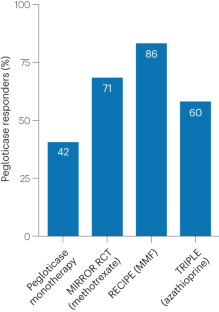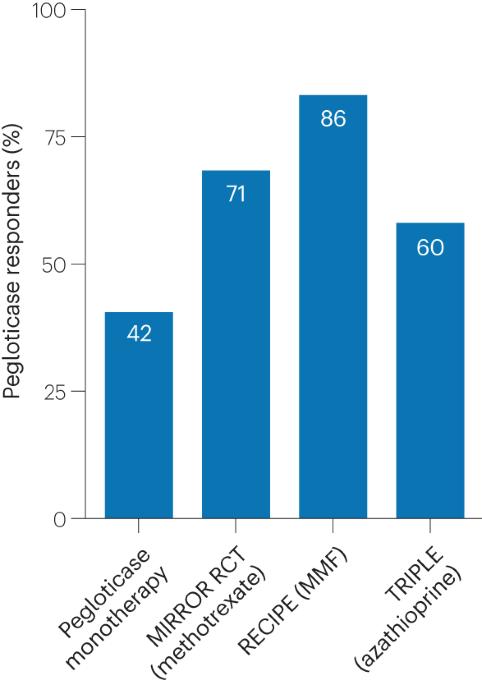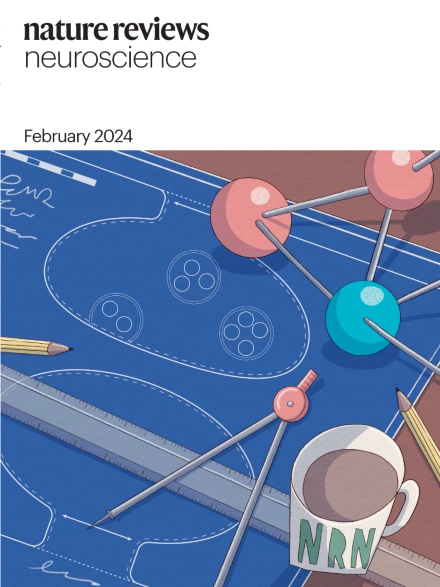Mechanisms and rationale for uricase use in patients with gout
IF 29.4
1区 医学
Q1 RHEUMATOLOGY
引用次数: 0
Abstract
Xanthine oxidase inhibitors such as allopurinol and febuxostat have been the mainstay urate-lowering therapy (ULT) for treating hyperuricaemia in patients with gout. However, not all patients receiving oral ULT achieve the target serum urate level, in part because some patients cannot tolerate, or have actual or misconceived contraindications to, their use, mainly due to comorbidities. ULT dosage is also limited by formularies and clinical inertia. This failure to sufficiently lower serum urate levels can lead to difficult-to-treat or uncontrolled gout, usually due to poorly managed and/or under-treated gout. In species other than humans, uricase (urate oxidase) converts urate to allantoin, which is more soluble in urine than uric acid. Exogenic uricases are an exciting therapeutic option for patients with gout. They can be viewed as enzyme replacement therapy. Uricases are being used to treat uncontrolled gout, and can achieve rapid reduction of hyperuricaemia, dramatic resolution of tophi, decreased chronic joint pain and improved quality of life. Availability, cost and uricase immunogenicity have limited their use. Uricases could become a leading choice in severe and difficult-to-treat gout as induction and/or debulking therapy (that is, for lowering of the urate pool) to be followed by chronic oral ULT. This Review summarizes the evidence regarding available uricases and those in the pipeline, their debulking effect and their outcomes related to gout and beyond. In this Review, the authors provide an overview of the therapeutic effects of uricases, outcomes related to gout and its comorbidities in clinical trials and challenges surrounding the use of uricases as potent urate-lowering therapy for the treatment of gout.


痛风患者使用尿酸酶的机制和原理。
黄嘌呤氧化酶抑制剂,如别嘌呤醇和非布司他,一直是治疗痛风患者高尿酸血症的主要降尿酸疗法(ULT)。然而,并非所有接受口服ULT的患者都达到了目标血清尿酸盐水平,部分原因是一些患者无法耐受或有实际或错误的禁忌症,主要是由于合并症。ULT剂量也受到配方和临床惯性的限制。这种未能充分降低血清尿酸盐水平的情况可能导致难以治疗或无法控制的痛风,通常是由于痛风管理不善和/或治疗不足。在人类以外的物种中,尿酸酶(尿酸氧化酶)将尿酸盐转化为尿囊素,尿囊素比尿酸更易溶于尿液。外源性尿酸酶是痛风患者令人兴奋的治疗选择。它们可以被视为酶替代疗法。尿壶被用于治疗不受控制的痛风,可以快速降低高尿酸血症,显著缓解痛风,减少慢性关节疼痛,提高生活质量。可用性、成本和尿酸酶免疫原性限制了它们的使用。在严重和难以治疗的痛风中,尿酸可能成为一种主要的选择,作为诱导和/或降压治疗(即降低尿酸盐库),然后进行慢性口服ULT。本综述总结了有关可用尿酸酶和正在进行中的尿酸酶的证据,其降压效果及其与痛风及其他疾病相关的结果。
本文章由计算机程序翻译,如有差异,请以英文原文为准。
求助全文
约1分钟内获得全文
求助全文
来源期刊

Nature Reviews Rheumatology
医学-风湿病学
CiteScore
29.90
自引率
0.90%
发文量
137
审稿时长
6-12 weeks
期刊介绍:
Nature Reviews Rheumatology is part of the Nature Reviews portfolio of journals. The journal scope covers the entire spectrum of rheumatology research. We ensure that our articles are accessible to the widest possible audience.
 求助内容:
求助内容: 应助结果提醒方式:
应助结果提醒方式:


